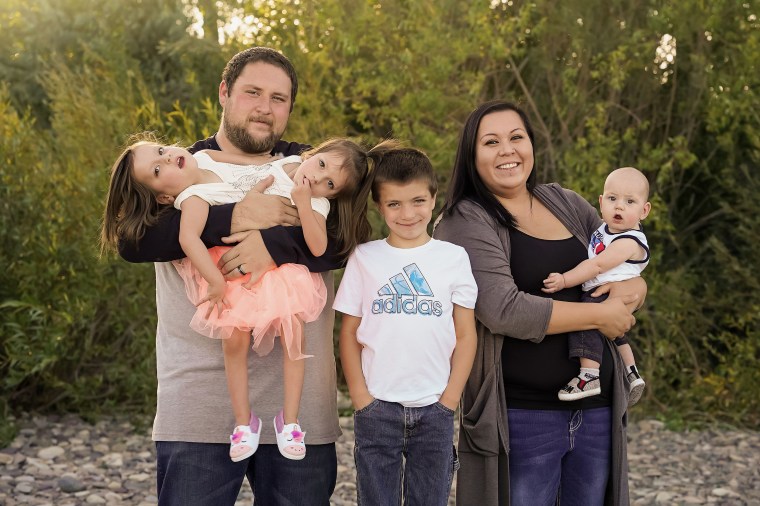Chelsea Torres used keep her conjoined twin daughters, Callie and Carter, concealed under a blanket in their stroller.
“When they were babies it was hard for me. People would stare and take pictures. I actually ended up smashing someone’s phone,” Torres, 30, tells TODAY.com. “It was just easier to hide them.”
But a lot has changed since then.
Callie and Carter are now 6 years old, and more visible than ever. To raise awareness about differences, Torres shares photos and videos on social media of the kindergartners as they navigate life with a shared body.
“You’ll see us at the mall and at expos. We’re always out doing something. During the summer, we live at the pool,” Torres, a pharmacy technician in Blackfoot, Idaho, says.
Callie and Carter are connected from the sternum down. They have separate hearts and stomachs, but share a liver, intestinal tract and bladder. Each girl controls one leg.
Conjoined twins are estimated to occur once in every 50,000 to 60,000 births, according to Children's Hospital of Philadelphia. Approximately 70% of conjoined twins are female and most are stillborn or die shortly after delivery.
"Carter needed oxygen for two hours, but that was it," Torres says. "The only reason they spent five weeks in the hospital is because we were waiting on a special car seat to arrive."
Torres says she and her husband, Nick, have no plans at this time for Callie and Carter to undergo separation surgery.

“They don’t have any health issues,” Torres says, adding that 24-hour surgery is “extremely risky.” Their age is also a factor: Callie and Carter turned 6 in January.
“Doctors recommend doing it before the age of 4, because they won’t remember the pain,” Torres explains. She notes that neither Callie nor Carter has ever expressed a desire to be separated.
“They don't know any other way of life," Torres says. "When people ask if they want to be separated, they're like, 'Huh? Why?'"
Dr. Steven Stylianos, who is surgeon-in-chief at NewYork-Presbyterian Morgan Stanley Children’s Hospital and has not treated the Torres twins, says that separation surgeries in cases like theirs generally have good survival rates.
"It's a very demanding operation, but since they have separate hearts, heads and brains, they're in good shape," Stylianos tells TODAY.com. "If they survived their birth, they usually can be separated with high expectations."
Stylianos says that conjoined twins can live out a normal lifespan.
"It's heartbreaking at the end. One of the twins will get an illness that is deemed non-survivable. In many instances, the healthier twin will be offered an emergency separation surgery, but they'll say, 'No, I'll go with my sister,'" Stylianos says.
Though Callie and Carter are identical twins, Torres says their personalities could not be more different. She describes Callie as “really girly,” while Carter could not care less about lip gloss, and gravitates towards video games and her 9-year-old brother, Jaysin.
When the girls need a break from each other, one will put on headphones and watch TV on a tablet.
“We try to give them their own time, even though they’re kind of like stuck together,” Torres says.

For Torres, the most challenging thing about having conjoined twins is having to sew all their clothes. She'll buy two dresses, shirts or jackets, cut them up, and stitch them together.
Callie and Carter have also grown out of their custom car seat.
Shriners Hospital for Children in Salt Lake City, Utah has a car seat clinic for children with special needs, but Torres says the next available appointment isn't until September.
“Stuff like that is frustrating," Torres says.
But she prefers to focus on the positive, like how Callie and Carter love school — and each other.
“They caress each other's legs. Sometimes when Carter is anxious, she’ll draw a circle on Callie’s leg with her finger and just keep following it,” Torres reveals.
The sisters get around in a wheelchair, and are learning how to walk and coordinate their movements in physical therapy. At the moment, they are able to take 40 steps.
Torres says she is hopeful about their future. Through social media she's connected with adult conjoined twins, who drive, date and have fulfilling careers.
"Yes, they're going to have challenges, but I know they're going to be just fine because they have each other," Torres tells TODAY.com.
Related video: